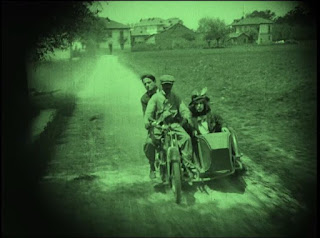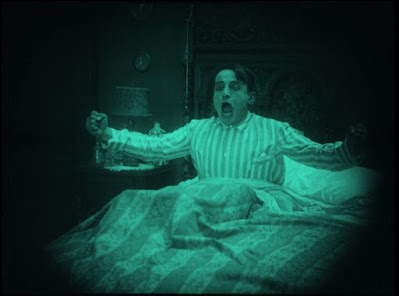“Cinema must be a messenger for propaganda: for
righteousness, for goodness, for honesty, for the noblest human and societal
feelings. In short, it must educate while entertaining.” Carlo
Campogalliani
This special Limited Edition of Le Giornate, does not
feature the usual live accompaniment and it was fascinating to listen in to today’s
Masterclass with five of the Festival’s musicians discussing the different challenges
of recording what are normally one off improvisations. Chaired by John Sweeney,
the panel featured Philip Carli, Mauro Colombis, José María Serralde Ruiz and
Daan van den Hurk.
Philip Carli dislikes recording in this context ask it
makes him all too aware of passages and musical decisions that he would do
differently given a second take; nevertheless he recorded his accompaniment for
Where Lights Are Low (1921) in one take as if live. Jose also adopted
the performance style for his but Daan took longer over his recording as he was
playing a previously arranged score for the Bioscope compilation which made for
the different challenge of obtaining the most accurate takes and one that
supports the discipline of short films of varying length and tone.
John highlighted the lack of audience as the crucial
third part of the improvisational “live” experience” whilst he also recorded on
midi so he could edit his work. This led him to worries about losing that constantly
shifting awareness and response to the timing of the film he gets from playing
live which has in the past, he feels, challenged his sense of continuity with
the source material.
 |
| The Famous Five |
This is fascinating for non-musicians and not surprising
for a group of players who improvise for a living. It also goes to the very nub
of the “live” silent cinema experience, the three-way interplay between sound, screen,
and auditorium. Now we have all these elements in place but just not in the
same space or even at the same time with some viewing on “catch-up”. The music,
the film, the audience are all out of joint and yet… it still works powered by
our digitised intimacy and propped up by social media, comments, and other direct
connections.
Most importantly, it’s not only the musicians who treat
their contribution as a performance, the audience does to; that’s the way it
works best and we’re all viewing with hard-wired expectations and responses –
memory and imagination plugs the gap and I wake up every day feeling the
Festival spirit. If only I had proper Italian coffee and cornetto alla
marmellata… I can almost smell them.
 |
| Coming up: phototelephonophotography! |
Quoting Elmer Bernstein, John said you have to align with the heartbeat of a film and all agreed that, even with films they’ve played for unseen, the best accompaniments have come when they’ve become submerged in the events on screen.There was a discussion about authenticity in terms of the musical themes used and there was a feeling of being “imposters” – albeit highly-skilled ones - overlaying musical suppositions onto defined works of art with often unknowable agendas. Then Mr Carli suggested that, as much as anybody on screen, “we are actors… doing our best with parts…” and then a giant penny dropped. Most silent films weren’t tightly scripted for dialogue with performers having to constantly improvise and the musicians are still carrying this process forward every tiem they connect with the action on screen.
It is always good to hear
more about a process that, for me, is almost indistinguishable from magic and which is essential to the silent film experience. I’m
also pretty sure there could be a reality TV series in this, Five Pianists
Go Busking perhaps or maybe just Go into a Bar?
 |
| Carlo Campogalliani and Letizia Quaranta |
At least Günter Buchwald and Frank Bockius had each other
for company when creating their accompaniment for today’s main feature, La
tempesta in un cranio (1921) aka Kill or Cure, rather appropriately
for this moment.
Directed, co-scripted and starring “the Italian Fairbanks”,
Carlo Campogalliani, the film was an energetic and light-hearted affair, featuring
an experiment in “phototelephonophotography” – something like a
prototypical Zoom call - as well as much running, jumping and climbing. Presented
in a new 2K digital restoration by MIC LAB of the tinted and toned period
nitrate print held at the Fondazione Cineteca Italiana in Milan it looked like
one of Doug’s more fevered dreams.
The film announces itself as being based on a (fictional) book by one by Alfredo Ariberti, Tempest in the Cranium, an hygienic-curative novel against neurasthenia… and proceeds to show the history of the De Otis family for whom every generation eventually becomes deranged. Campogalliani plays Renato De Ortis, “the last descendant of a line of lunatics, wealthy, noble, beloved…” by his lady Liana (Carlo’s wife, Letizia Quaranta) and yet worn down by his fear of this inherited insanity. His home is laden down with books on the mind, life curtailed by the fear of turning into the next deranged De Otis. Can the cycle be broken?
 |
| Mad with worry |
But how can I think of the smiles of life when I'm
under the most terrible ancestral threat?
Renato’s friends set about trying to get him to snap back to life and the above mentioned novelist, Alfredo Ariberti, brings him a specialist, Professor Valenti, who recommends he do more exercise and stop reading books; his muscles are inert because of idleness and I know the feeling! But Renato can barely lift a small dumbbell and slips back into his stupor… as his friends fret about how to help him.
Strange and unfortunate things start happening as Renato’s
mines are flooded following a volcanic eruption and his remaining money is
stolen in a burglary; life seems to be taking a turn for the worst and after a
deep and disturbed sleep he finds himself waking up under a park bench… The
Storm in the Cranium is about to begin!
 |
| No hanging around, not in this film. |
Now the film picks up a pace and Renato goes on a
breathless adventure during which he gets accused of being a master criminal,
chased repeatedly by the police and encounters a scientist and his daughter.
The scientist is working on a televisual telephone and there are enemy agents
aplenty out to stop him and steak his idea, they kidnap the boffin and his
backer and then try to finish Renato and the girl by tying them up in chains in
a mill house, the grinding stone moving down ever closer to the maiden in
distress as Renato does his Douglas-best to stop it.
 |
| Go to the Giornate site as soon as you can! |
Different premise but the film did remind me of the
Fairbanks film When the Clouds Roll By (1919) and Campogalliani shows
similar levels of aerobic invention as he free-runs through the film. It’s not so much madcap as motivational and,
whilst it’s exhaustingly daft, going back to Campogalliani’s quote at the top,
perhaps the message to us all to get up and get out a lot more!
Günter and Frank kept up with all the manic movement,
making musical sense of the madness by injecting some wondrous wacky lines of
their own over percussive pandemonium. This is probably not a good film to
accompany unseen but I’m certain these two would cope; there’s never one way to
improvise and circumstance as well as cine-film, lead to the maximum level of “known
unknowns” especially given the amount of cine-telepathy they have.























No comments:
Post a Comment